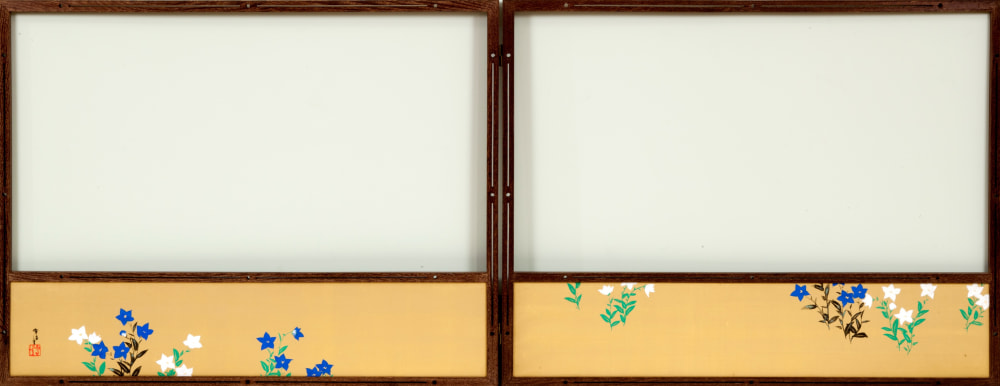
KAMISAKA SEKKA (1866-1942)
Two-fold tea screen with flower paintings in inset panels, front and back
1920-40
Color with gold and silver wash on paper; mulberry carved wooden
frame (kua)
Dimensions: 28 3/4 x 36 3/4 in. (each wooden frame-panel);
7 x 35 in. (each painted panel)
$ 19,500
The work of Kamisaka Sekka defines Japan’s modern art movement and this masterful screen is an exceptional example of his highly decorative style that combines the celebrated traditions of stylized imagery of the Rimpa school of painting with the bold lines of modern design. Sekka produced other paintings of bellflowers and autumn grasses with similar painting techniques (see pls. 44-49 and 60-62) in Kamisaka Sekka: Rimpa Master, Pioneer of Modern Design).
Kamisaka Sekka occupies a unique position in the history of Japanese modern art. Unlike his contemporaries, his achievements were not limited to the sphere of painting, but also included designing lacquer ware, ceramics, and textiles. Born in 1866, two years before the Meiji Restoration, Sekka began his study of painting at age sixteen in the Shijô school tradition under Suzuki Zuigen (1847-1901). His first professional job was as a designer for the Kyoto Kawashima textile company, but exposure to European decorative art convinced him to change course. In 1888, at age 23, Sekka began to study Rimpa-style painting under Kishi Kôkei (1840-1922) in Tokyo. The Rimpa tradition, which became Sekka’s lifelong path, was considered a uniquely Japanese form of aesthetic expression. Despite societal pressure to look only at painting as art, he worked toward preserving the tradition of arts and crafts by successfully integrating various materials, sometimes producing mixed media works like this screen with its intricately woven textile applied to the bottom half of the composition.

In 1901, Sekka went to Europe to see the Paris International Exposition and took the opportunity to visit numerous European museums. Upon his return to Japan, he accepted a teaching post at the Kyoto Municipal School of Arts and Crafts, began a long career in judging both fine and decorative arts at numerous competitions in Japan and later in France. Soon thereafter, Sekka organized two groups of Kyoto based artists that later merged into the Katsumikai, which changed its name many times but survived in one form or another until 1939. The mission of this group was to study the applied arts, sponsor public semiannual exhibitions, conduct seminars, publish magazines, and so on. In this way, Sekka became the unifying and driving force in the revitalization of the decorative arts of Kyoto and a leader in Japan’s modern art movement.
In addition, he personally contributed to the re-evaluation of the prominent artists in his beloved Rimpa tradition, by first establishing the Kôetsukai, which threw new light on the now celebrated artist Hon’ami Kôetsu (1558-1637), also a gifted calligrapher, designer, and producer, and then through events honoring Ogata Kôrin (1658-1716). In his own work, he paid artistic homage to their genius, through his effective use of techniques, subject matter, and style all initially pioneered by these masters.
References:
Wood Donald A., and Yuko Ikeda, ed. Kamisaka Sekka: Rimpa Master, Pioneer of Modern Design (Kyoto: National Museum of Modern Art, 2003), especially, Sakakibara Yoshio, “A Study of Kamisaka Sekka,” 13-29.
Gendai no rimpa––Kamisaka Sekka, Kyoto Shoin. 1982.
Vos, Frits, et al. MEIJI: Japanese Art in Transition: Ceramics. Cloisonné, Lacquer, Prints (Gravenhage, Netherlands: Haags Gemeentemuseum, 1987) pls. 397-98.